MOD006890: Report on Marketing and Demand Management in Healthcare
VerifiedAdded on 2023/06/14
|11
|3267
|291
Report
AI Summary
This report analyzes marketing and demand management strategies for expanding healthcare services in the Hammersmith and Fulham borough, focusing on cardiovascular health as a key priority. It includes a competitor analysis using Porter's Five Forces, recommending a smart wearable device for monitoring heart conditions. The report details a service delivery model based on co-location with healthcare professionals and pharmaceutical representatives, emphasizing service culture, employee engagement, service quality, and customer experience. The target market is segmented using psychographic and demographic approaches, positioning the company as offering affordable, advanced technology. The marketing mix includes product, price, place, and promotion strategies, with a focus on demand management and demarketing to effectively manage fluctuations in demand. The report uses data analysis to determine consumer expectations and competitor strategies, employing quantitative methods to compare companies and consumer segments.
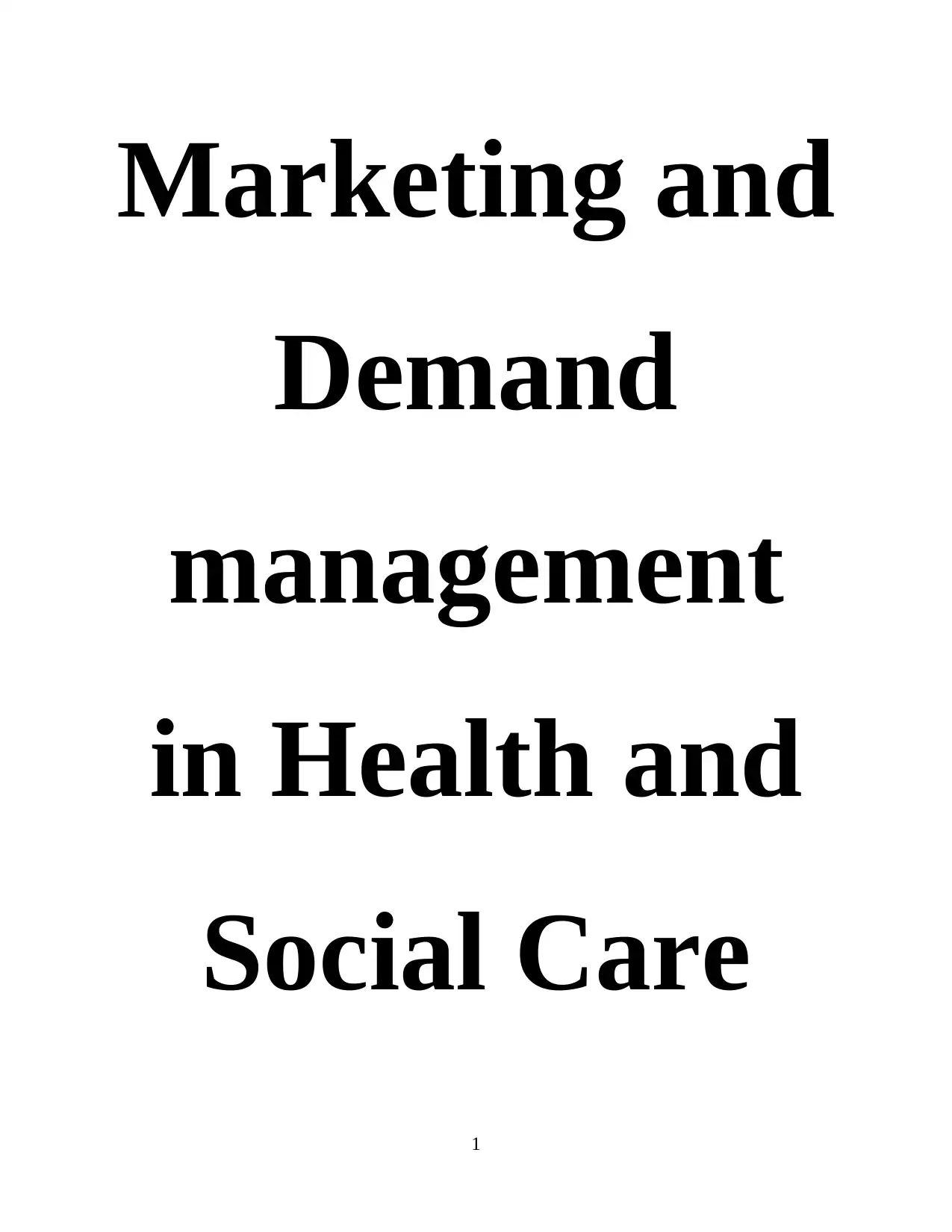
Marketing and
Demand
management
in Health and
Social Care
1
Demand
management
in Health and
Social Care
1
Paraphrase This Document
Need a fresh take? Get an instant paraphrase of this document with our AI Paraphraser
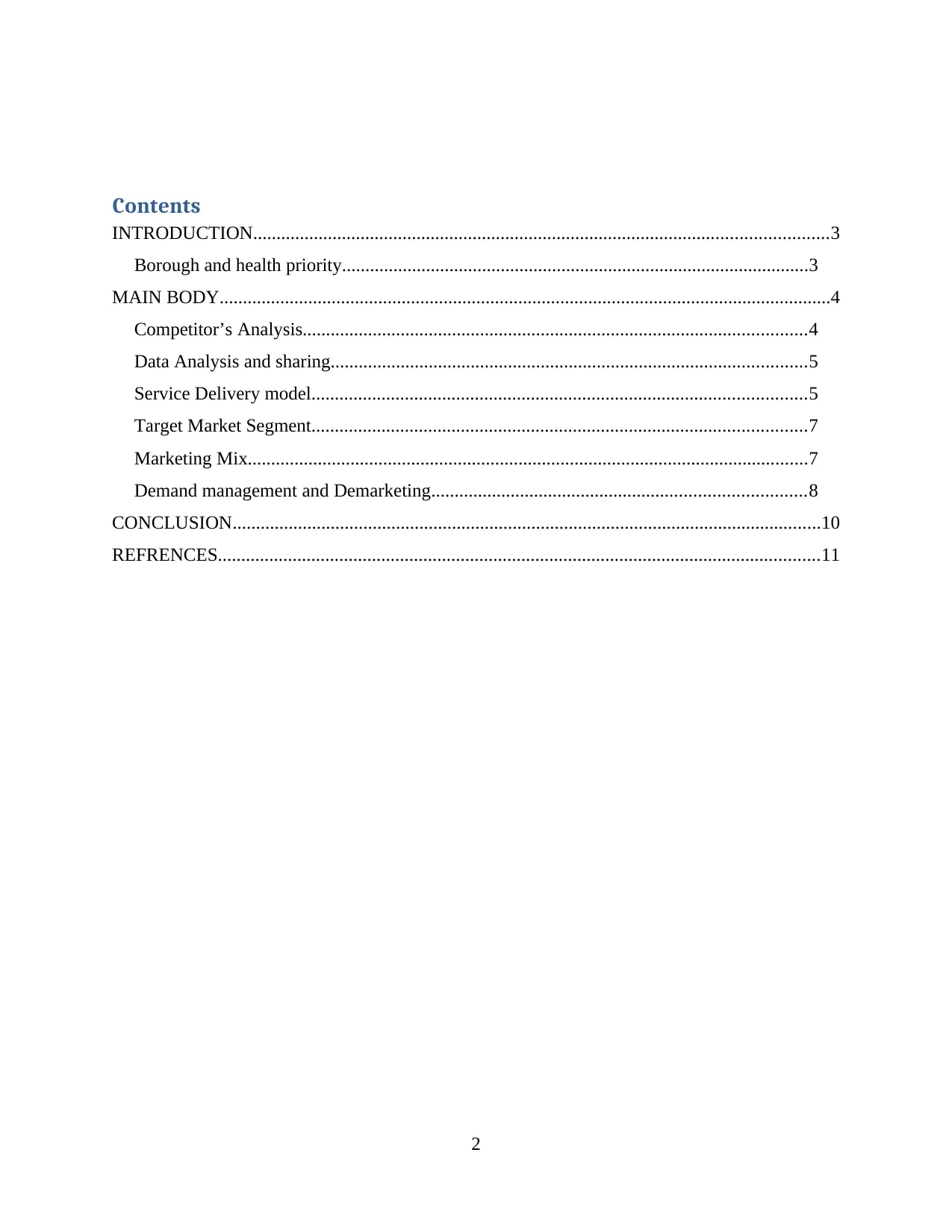
Contents
INTRODUCTION...........................................................................................................................3
Borough and health priority....................................................................................................3
MAIN BODY...................................................................................................................................4
Competitor’s Analysis............................................................................................................4
Data Analysis and sharing......................................................................................................5
Service Delivery model..........................................................................................................5
Target Market Segment..........................................................................................................7
Marketing Mix........................................................................................................................7
Demand management and Demarketing................................................................................8
CONCLUSION..............................................................................................................................10
REFRENCES.................................................................................................................................11
2
INTRODUCTION...........................................................................................................................3
Borough and health priority....................................................................................................3
MAIN BODY...................................................................................................................................4
Competitor’s Analysis............................................................................................................4
Data Analysis and sharing......................................................................................................5
Service Delivery model..........................................................................................................5
Target Market Segment..........................................................................................................7
Marketing Mix........................................................................................................................7
Demand management and Demarketing................................................................................8
CONCLUSION..............................................................................................................................10
REFRENCES.................................................................................................................................11
2
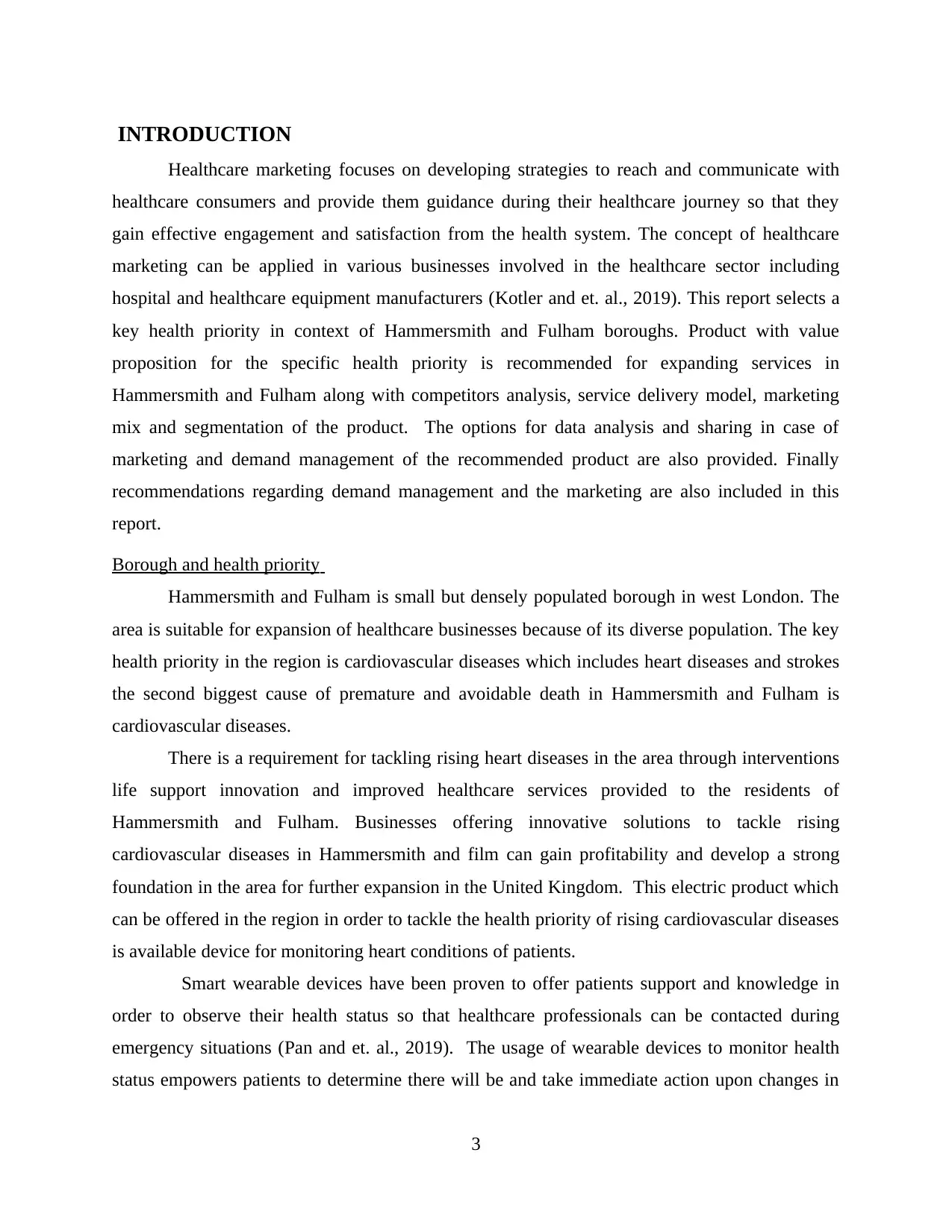
INTRODUCTION
Healthcare marketing focuses on developing strategies to reach and communicate with
healthcare consumers and provide them guidance during their healthcare journey so that they
gain effective engagement and satisfaction from the health system. The concept of healthcare
marketing can be applied in various businesses involved in the healthcare sector including
hospital and healthcare equipment manufacturers (Kotler and et. al., 2019). This report selects a
key health priority in context of Hammersmith and Fulham boroughs. Product with value
proposition for the specific health priority is recommended for expanding services in
Hammersmith and Fulham along with competitors analysis, service delivery model, marketing
mix and segmentation of the product. The options for data analysis and sharing in case of
marketing and demand management of the recommended product are also provided. Finally
recommendations regarding demand management and the marketing are also included in this
report.
Borough and health priority
Hammersmith and Fulham is small but densely populated borough in west London. The
area is suitable for expansion of healthcare businesses because of its diverse population. The key
health priority in the region is cardiovascular diseases which includes heart diseases and strokes
the second biggest cause of premature and avoidable death in Hammersmith and Fulham is
cardiovascular diseases.
There is a requirement for tackling rising heart diseases in the area through interventions
life support innovation and improved healthcare services provided to the residents of
Hammersmith and Fulham. Businesses offering innovative solutions to tackle rising
cardiovascular diseases in Hammersmith and film can gain profitability and develop a strong
foundation in the area for further expansion in the United Kingdom. This electric product which
can be offered in the region in order to tackle the health priority of rising cardiovascular diseases
is available device for monitoring heart conditions of patients.
Smart wearable devices have been proven to offer patients support and knowledge in
order to observe their health status so that healthcare professionals can be contacted during
emergency situations (Pan and et. al., 2019). The usage of wearable devices to monitor health
status empowers patients to determine there will be and take immediate action upon changes in
3
Healthcare marketing focuses on developing strategies to reach and communicate with
healthcare consumers and provide them guidance during their healthcare journey so that they
gain effective engagement and satisfaction from the health system. The concept of healthcare
marketing can be applied in various businesses involved in the healthcare sector including
hospital and healthcare equipment manufacturers (Kotler and et. al., 2019). This report selects a
key health priority in context of Hammersmith and Fulham boroughs. Product with value
proposition for the specific health priority is recommended for expanding services in
Hammersmith and Fulham along with competitors analysis, service delivery model, marketing
mix and segmentation of the product. The options for data analysis and sharing in case of
marketing and demand management of the recommended product are also provided. Finally
recommendations regarding demand management and the marketing are also included in this
report.
Borough and health priority
Hammersmith and Fulham is small but densely populated borough in west London. The
area is suitable for expansion of healthcare businesses because of its diverse population. The key
health priority in the region is cardiovascular diseases which includes heart diseases and strokes
the second biggest cause of premature and avoidable death in Hammersmith and Fulham is
cardiovascular diseases.
There is a requirement for tackling rising heart diseases in the area through interventions
life support innovation and improved healthcare services provided to the residents of
Hammersmith and Fulham. Businesses offering innovative solutions to tackle rising
cardiovascular diseases in Hammersmith and film can gain profitability and develop a strong
foundation in the area for further expansion in the United Kingdom. This electric product which
can be offered in the region in order to tackle the health priority of rising cardiovascular diseases
is available device for monitoring heart conditions of patients.
Smart wearable devices have been proven to offer patients support and knowledge in
order to observe their health status so that healthcare professionals can be contacted during
emergency situations (Pan and et. al., 2019). The usage of wearable devices to monitor health
status empowers patients to determine there will be and take immediate action upon changes in
3
⊘ This is a preview!⊘
Do you want full access?
Subscribe today to unlock all pages.

Trusted by 1+ million students worldwide
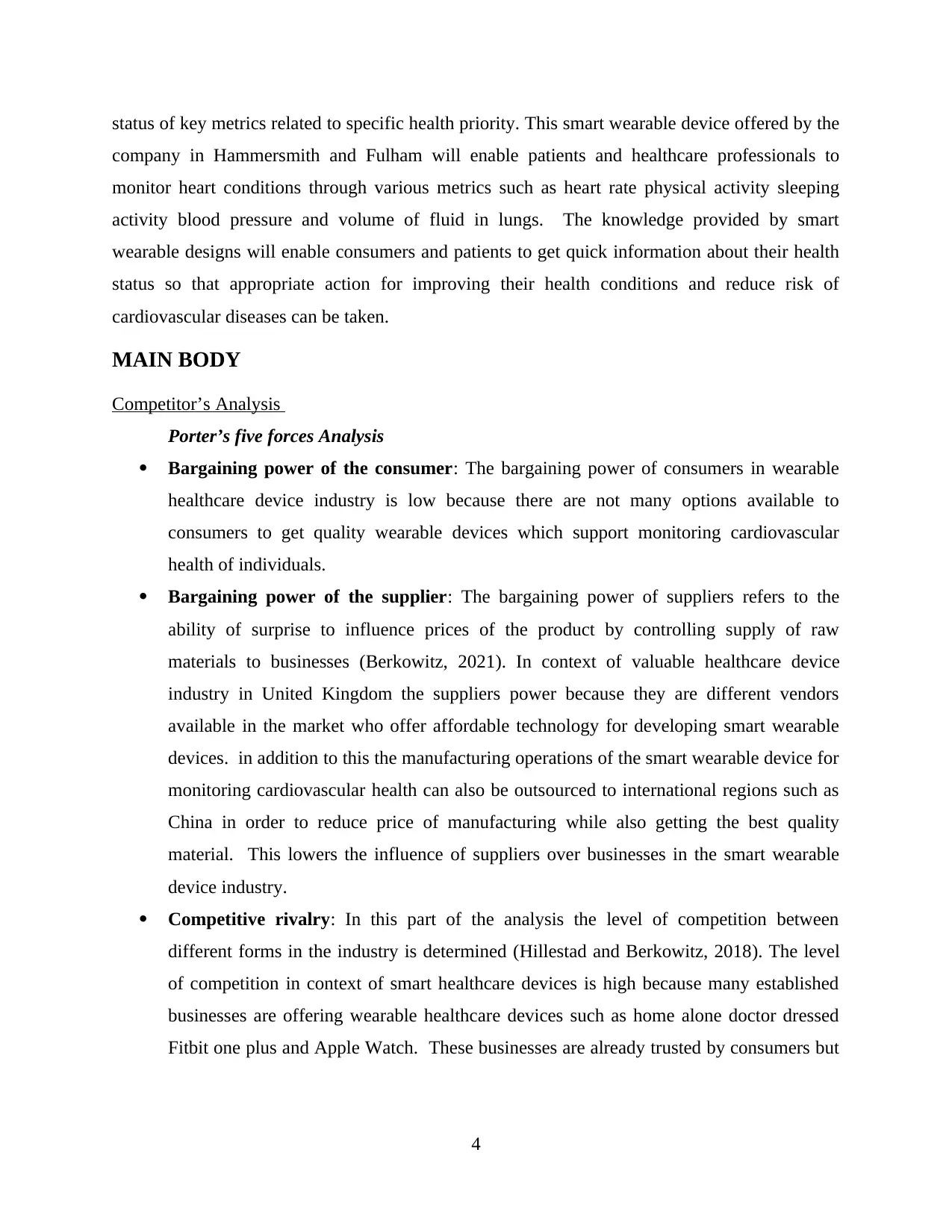
status of key metrics related to specific health priority. This smart wearable device offered by the
company in Hammersmith and Fulham will enable patients and healthcare professionals to
monitor heart conditions through various metrics such as heart rate physical activity sleeping
activity blood pressure and volume of fluid in lungs. The knowledge provided by smart
wearable designs will enable consumers and patients to get quick information about their health
status so that appropriate action for improving their health conditions and reduce risk of
cardiovascular diseases can be taken.
MAIN BODY
Competitor’s Analysis
Porter’s five forces Analysis
Bargaining power of the consumer: The bargaining power of consumers in wearable
healthcare device industry is low because there are not many options available to
consumers to get quality wearable devices which support monitoring cardiovascular
health of individuals.
Bargaining power of the supplier: The bargaining power of suppliers refers to the
ability of surprise to influence prices of the product by controlling supply of raw
materials to businesses (Berkowitz, 2021). In context of valuable healthcare device
industry in United Kingdom the suppliers power because they are different vendors
available in the market who offer affordable technology for developing smart wearable
devices. in addition to this the manufacturing operations of the smart wearable device for
monitoring cardiovascular health can also be outsourced to international regions such as
China in order to reduce price of manufacturing while also getting the best quality
material. This lowers the influence of suppliers over businesses in the smart wearable
device industry.
Competitive rivalry: In this part of the analysis the level of competition between
different forms in the industry is determined (Hillestad and Berkowitz, 2018). The level
of competition in context of smart healthcare devices is high because many established
businesses are offering wearable healthcare devices such as home alone doctor dressed
Fitbit one plus and Apple Watch. These businesses are already trusted by consumers but
4
company in Hammersmith and Fulham will enable patients and healthcare professionals to
monitor heart conditions through various metrics such as heart rate physical activity sleeping
activity blood pressure and volume of fluid in lungs. The knowledge provided by smart
wearable designs will enable consumers and patients to get quick information about their health
status so that appropriate action for improving their health conditions and reduce risk of
cardiovascular diseases can be taken.
MAIN BODY
Competitor’s Analysis
Porter’s five forces Analysis
Bargaining power of the consumer: The bargaining power of consumers in wearable
healthcare device industry is low because there are not many options available to
consumers to get quality wearable devices which support monitoring cardiovascular
health of individuals.
Bargaining power of the supplier: The bargaining power of suppliers refers to the
ability of surprise to influence prices of the product by controlling supply of raw
materials to businesses (Berkowitz, 2021). In context of valuable healthcare device
industry in United Kingdom the suppliers power because they are different vendors
available in the market who offer affordable technology for developing smart wearable
devices. in addition to this the manufacturing operations of the smart wearable device for
monitoring cardiovascular health can also be outsourced to international regions such as
China in order to reduce price of manufacturing while also getting the best quality
material. This lowers the influence of suppliers over businesses in the smart wearable
device industry.
Competitive rivalry: In this part of the analysis the level of competition between
different forms in the industry is determined (Hillestad and Berkowitz, 2018). The level
of competition in context of smart healthcare devices is high because many established
businesses are offering wearable healthcare devices such as home alone doctor dressed
Fitbit one plus and Apple Watch. These businesses are already trusted by consumers but
4
Paraphrase This Document
Need a fresh take? Get an instant paraphrase of this document with our AI Paraphraser
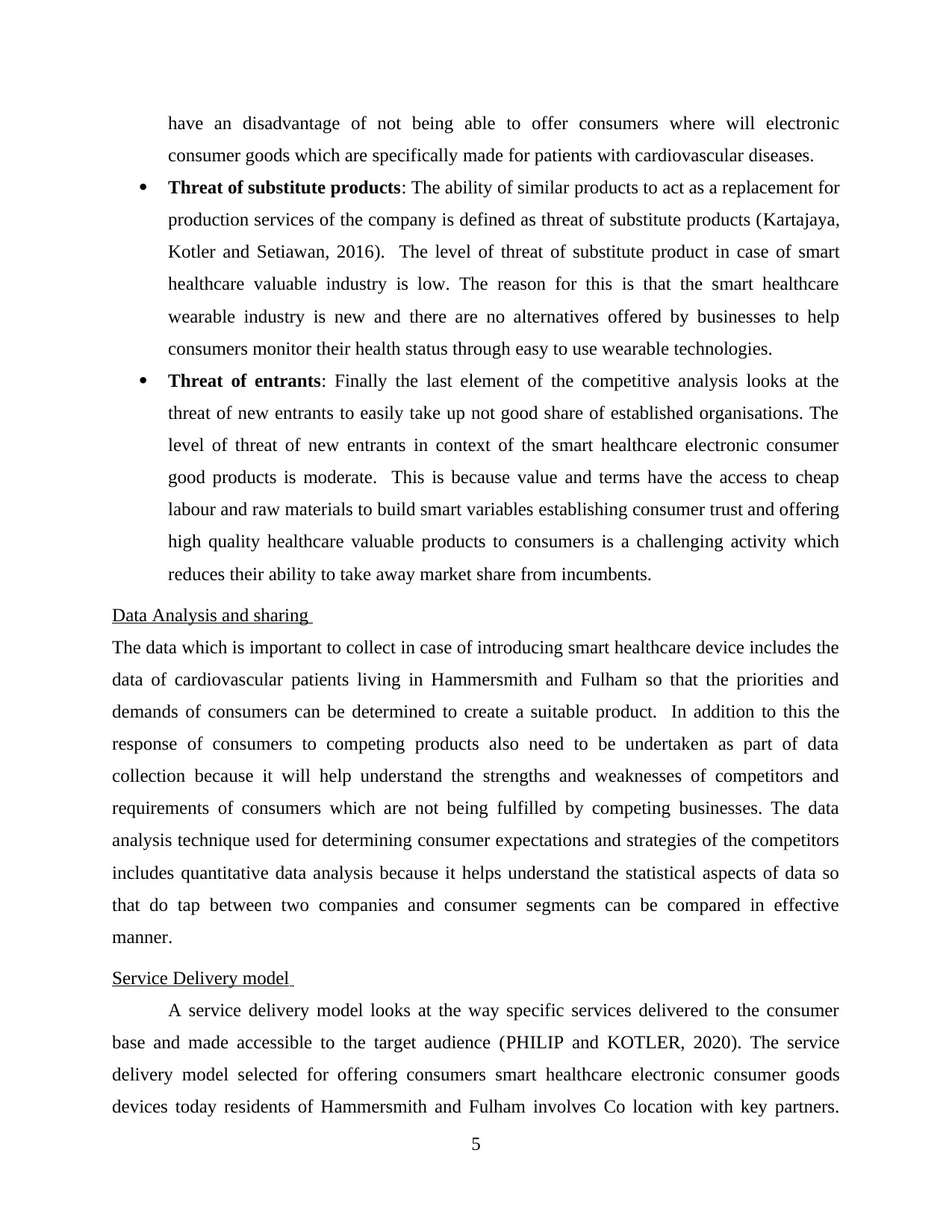
have an disadvantage of not being able to offer consumers where will electronic
consumer goods which are specifically made for patients with cardiovascular diseases.
Threat of substitute products: The ability of similar products to act as a replacement for
production services of the company is defined as threat of substitute products (Kartajaya,
Kotler and Setiawan, 2016). The level of threat of substitute product in case of smart
healthcare valuable industry is low. The reason for this is that the smart healthcare
wearable industry is new and there are no alternatives offered by businesses to help
consumers monitor their health status through easy to use wearable technologies.
Threat of entrants: Finally the last element of the competitive analysis looks at the
threat of new entrants to easily take up not good share of established organisations. The
level of threat of new entrants in context of the smart healthcare electronic consumer
good products is moderate. This is because value and terms have the access to cheap
labour and raw materials to build smart variables establishing consumer trust and offering
high quality healthcare valuable products to consumers is a challenging activity which
reduces their ability to take away market share from incumbents.
Data Analysis and sharing
The data which is important to collect in case of introducing smart healthcare device includes the
data of cardiovascular patients living in Hammersmith and Fulham so that the priorities and
demands of consumers can be determined to create a suitable product. In addition to this the
response of consumers to competing products also need to be undertaken as part of data
collection because it will help understand the strengths and weaknesses of competitors and
requirements of consumers which are not being fulfilled by competing businesses. The data
analysis technique used for determining consumer expectations and strategies of the competitors
includes quantitative data analysis because it helps understand the statistical aspects of data so
that do tap between two companies and consumer segments can be compared in effective
manner.
Service Delivery model
A service delivery model looks at the way specific services delivered to the consumer
base and made accessible to the target audience (PHILIP and KOTLER, 2020). The service
delivery model selected for offering consumers smart healthcare electronic consumer goods
devices today residents of Hammersmith and Fulham involves Co location with key partners.
5
consumer goods which are specifically made for patients with cardiovascular diseases.
Threat of substitute products: The ability of similar products to act as a replacement for
production services of the company is defined as threat of substitute products (Kartajaya,
Kotler and Setiawan, 2016). The level of threat of substitute product in case of smart
healthcare valuable industry is low. The reason for this is that the smart healthcare
wearable industry is new and there are no alternatives offered by businesses to help
consumers monitor their health status through easy to use wearable technologies.
Threat of entrants: Finally the last element of the competitive analysis looks at the
threat of new entrants to easily take up not good share of established organisations. The
level of threat of new entrants in context of the smart healthcare electronic consumer
good products is moderate. This is because value and terms have the access to cheap
labour and raw materials to build smart variables establishing consumer trust and offering
high quality healthcare valuable products to consumers is a challenging activity which
reduces their ability to take away market share from incumbents.
Data Analysis and sharing
The data which is important to collect in case of introducing smart healthcare device includes the
data of cardiovascular patients living in Hammersmith and Fulham so that the priorities and
demands of consumers can be determined to create a suitable product. In addition to this the
response of consumers to competing products also need to be undertaken as part of data
collection because it will help understand the strengths and weaknesses of competitors and
requirements of consumers which are not being fulfilled by competing businesses. The data
analysis technique used for determining consumer expectations and strategies of the competitors
includes quantitative data analysis because it helps understand the statistical aspects of data so
that do tap between two companies and consumer segments can be compared in effective
manner.
Service Delivery model
A service delivery model looks at the way specific services delivered to the consumer
base and made accessible to the target audience (PHILIP and KOTLER, 2020). The service
delivery model selected for offering consumers smart healthcare electronic consumer goods
devices today residents of Hammersmith and Fulham involves Co location with key partners.
5
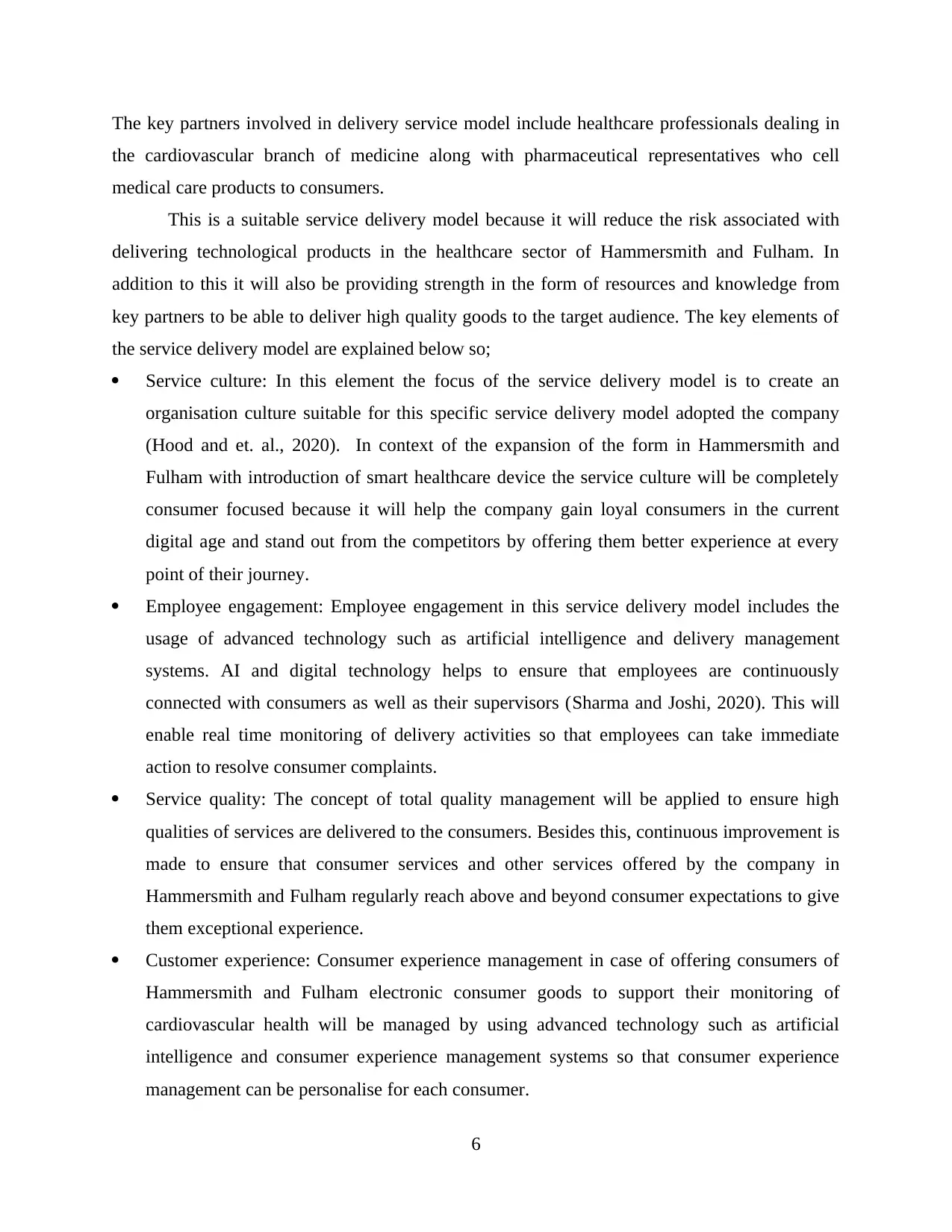
The key partners involved in delivery service model include healthcare professionals dealing in
the cardiovascular branch of medicine along with pharmaceutical representatives who cell
medical care products to consumers.
This is a suitable service delivery model because it will reduce the risk associated with
delivering technological products in the healthcare sector of Hammersmith and Fulham. In
addition to this it will also be providing strength in the form of resources and knowledge from
key partners to be able to deliver high quality goods to the target audience. The key elements of
the service delivery model are explained below so;
Service culture: In this element the focus of the service delivery model is to create an
organisation culture suitable for this specific service delivery model adopted the company
(Hood and et. al., 2020). In context of the expansion of the form in Hammersmith and
Fulham with introduction of smart healthcare device the service culture will be completely
consumer focused because it will help the company gain loyal consumers in the current
digital age and stand out from the competitors by offering them better experience at every
point of their journey.
Employee engagement: Employee engagement in this service delivery model includes the
usage of advanced technology such as artificial intelligence and delivery management
systems. AI and digital technology helps to ensure that employees are continuously
connected with consumers as well as their supervisors (Sharma and Joshi, 2020). This will
enable real time monitoring of delivery activities so that employees can take immediate
action to resolve consumer complaints.
Service quality: The concept of total quality management will be applied to ensure high
qualities of services are delivered to the consumers. Besides this, continuous improvement is
made to ensure that consumer services and other services offered by the company in
Hammersmith and Fulham regularly reach above and beyond consumer expectations to give
them exceptional experience.
Customer experience: Consumer experience management in case of offering consumers of
Hammersmith and Fulham electronic consumer goods to support their monitoring of
cardiovascular health will be managed by using advanced technology such as artificial
intelligence and consumer experience management systems so that consumer experience
management can be personalise for each consumer.
6
the cardiovascular branch of medicine along with pharmaceutical representatives who cell
medical care products to consumers.
This is a suitable service delivery model because it will reduce the risk associated with
delivering technological products in the healthcare sector of Hammersmith and Fulham. In
addition to this it will also be providing strength in the form of resources and knowledge from
key partners to be able to deliver high quality goods to the target audience. The key elements of
the service delivery model are explained below so;
Service culture: In this element the focus of the service delivery model is to create an
organisation culture suitable for this specific service delivery model adopted the company
(Hood and et. al., 2020). In context of the expansion of the form in Hammersmith and
Fulham with introduction of smart healthcare device the service culture will be completely
consumer focused because it will help the company gain loyal consumers in the current
digital age and stand out from the competitors by offering them better experience at every
point of their journey.
Employee engagement: Employee engagement in this service delivery model includes the
usage of advanced technology such as artificial intelligence and delivery management
systems. AI and digital technology helps to ensure that employees are continuously
connected with consumers as well as their supervisors (Sharma and Joshi, 2020). This will
enable real time monitoring of delivery activities so that employees can take immediate
action to resolve consumer complaints.
Service quality: The concept of total quality management will be applied to ensure high
qualities of services are delivered to the consumers. Besides this, continuous improvement is
made to ensure that consumer services and other services offered by the company in
Hammersmith and Fulham regularly reach above and beyond consumer expectations to give
them exceptional experience.
Customer experience: Consumer experience management in case of offering consumers of
Hammersmith and Fulham electronic consumer goods to support their monitoring of
cardiovascular health will be managed by using advanced technology such as artificial
intelligence and consumer experience management systems so that consumer experience
management can be personalise for each consumer.
6
⊘ This is a preview!⊘
Do you want full access?
Subscribe today to unlock all pages.

Trusted by 1+ million students worldwide
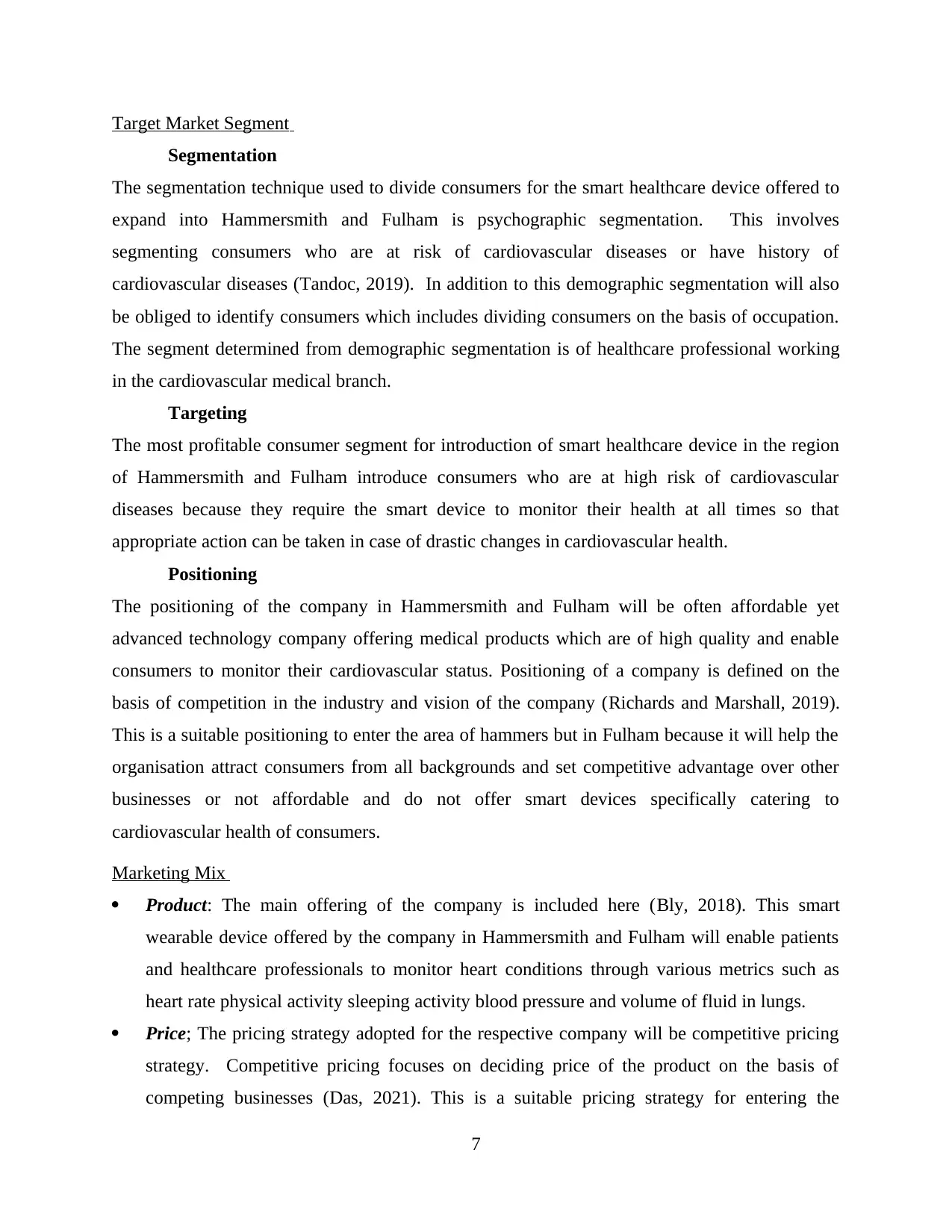
Target Market Segment
Segmentation
The segmentation technique used to divide consumers for the smart healthcare device offered to
expand into Hammersmith and Fulham is psychographic segmentation. This involves
segmenting consumers who are at risk of cardiovascular diseases or have history of
cardiovascular diseases (Tandoc, 2019). In addition to this demographic segmentation will also
be obliged to identify consumers which includes dividing consumers on the basis of occupation.
The segment determined from demographic segmentation is of healthcare professional working
in the cardiovascular medical branch.
Targeting
The most profitable consumer segment for introduction of smart healthcare device in the region
of Hammersmith and Fulham introduce consumers who are at high risk of cardiovascular
diseases because they require the smart device to monitor their health at all times so that
appropriate action can be taken in case of drastic changes in cardiovascular health.
Positioning
The positioning of the company in Hammersmith and Fulham will be often affordable yet
advanced technology company offering medical products which are of high quality and enable
consumers to monitor their cardiovascular status. Positioning of a company is defined on the
basis of competition in the industry and vision of the company (Richards and Marshall, 2019).
This is a suitable positioning to enter the area of hammers but in Fulham because it will help the
organisation attract consumers from all backgrounds and set competitive advantage over other
businesses or not affordable and do not offer smart devices specifically catering to
cardiovascular health of consumers.
Marketing Mix
Product: The main offering of the company is included here (Bly, 2018). This smart
wearable device offered by the company in Hammersmith and Fulham will enable patients
and healthcare professionals to monitor heart conditions through various metrics such as
heart rate physical activity sleeping activity blood pressure and volume of fluid in lungs.
Price; The pricing strategy adopted for the respective company will be competitive pricing
strategy. Competitive pricing focuses on deciding price of the product on the basis of
competing businesses (Das, 2021). This is a suitable pricing strategy for entering the
7
Segmentation
The segmentation technique used to divide consumers for the smart healthcare device offered to
expand into Hammersmith and Fulham is psychographic segmentation. This involves
segmenting consumers who are at risk of cardiovascular diseases or have history of
cardiovascular diseases (Tandoc, 2019). In addition to this demographic segmentation will also
be obliged to identify consumers which includes dividing consumers on the basis of occupation.
The segment determined from demographic segmentation is of healthcare professional working
in the cardiovascular medical branch.
Targeting
The most profitable consumer segment for introduction of smart healthcare device in the region
of Hammersmith and Fulham introduce consumers who are at high risk of cardiovascular
diseases because they require the smart device to monitor their health at all times so that
appropriate action can be taken in case of drastic changes in cardiovascular health.
Positioning
The positioning of the company in Hammersmith and Fulham will be often affordable yet
advanced technology company offering medical products which are of high quality and enable
consumers to monitor their cardiovascular status. Positioning of a company is defined on the
basis of competition in the industry and vision of the company (Richards and Marshall, 2019).
This is a suitable positioning to enter the area of hammers but in Fulham because it will help the
organisation attract consumers from all backgrounds and set competitive advantage over other
businesses or not affordable and do not offer smart devices specifically catering to
cardiovascular health of consumers.
Marketing Mix
Product: The main offering of the company is included here (Bly, 2018). This smart
wearable device offered by the company in Hammersmith and Fulham will enable patients
and healthcare professionals to monitor heart conditions through various metrics such as
heart rate physical activity sleeping activity blood pressure and volume of fluid in lungs.
Price; The pricing strategy adopted for the respective company will be competitive pricing
strategy. Competitive pricing focuses on deciding price of the product on the basis of
competing businesses (Das, 2021). This is a suitable pricing strategy for entering the
7
Paraphrase This Document
Need a fresh take? Get an instant paraphrase of this document with our AI Paraphraser
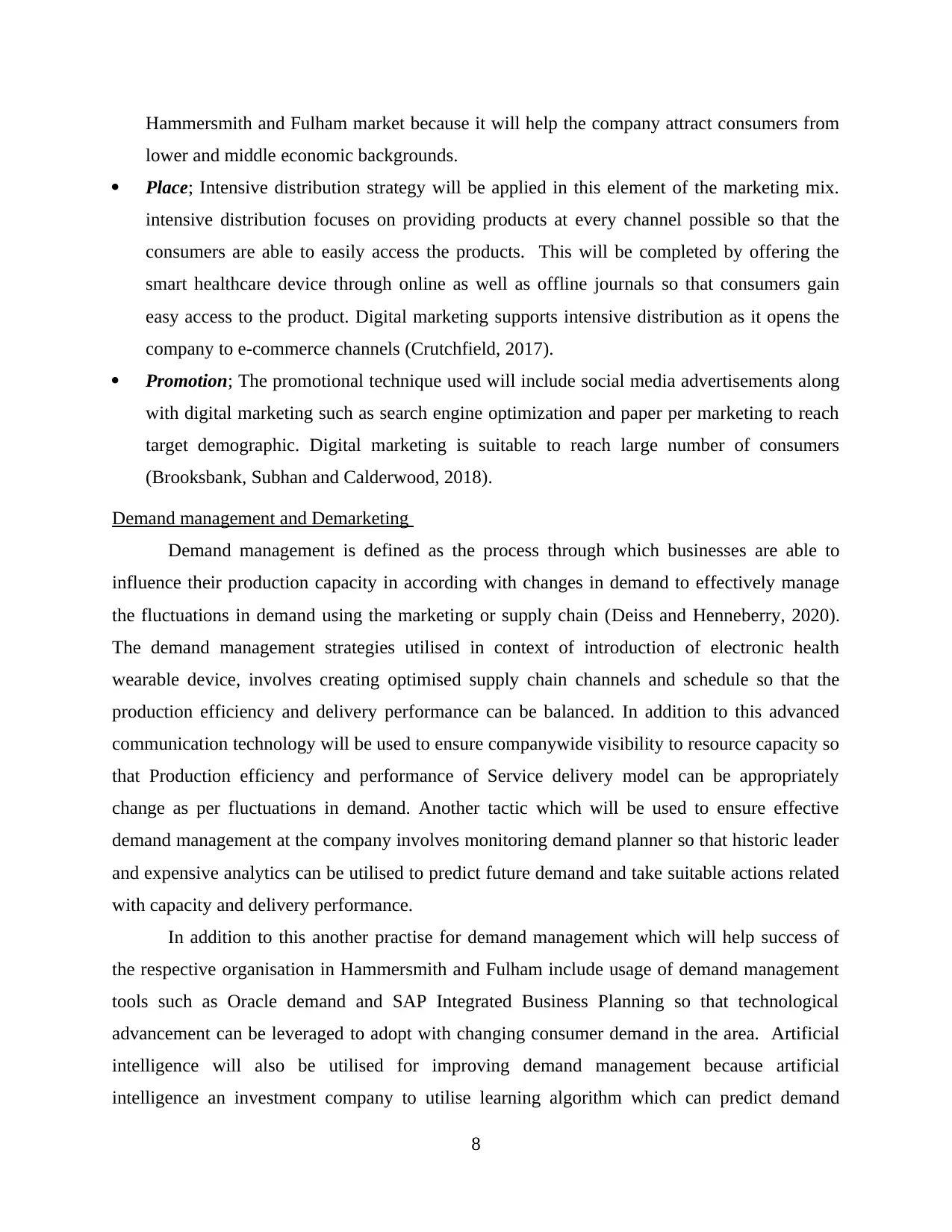
Hammersmith and Fulham market because it will help the company attract consumers from
lower and middle economic backgrounds.
Place; Intensive distribution strategy will be applied in this element of the marketing mix.
intensive distribution focuses on providing products at every channel possible so that the
consumers are able to easily access the products. This will be completed by offering the
smart healthcare device through online as well as offline journals so that consumers gain
easy access to the product. Digital marketing supports intensive distribution as it opens the
company to e-commerce channels (Crutchfield, 2017).
Promotion; The promotional technique used will include social media advertisements along
with digital marketing such as search engine optimization and paper per marketing to reach
target demographic. Digital marketing is suitable to reach large number of consumers
(Brooksbank, Subhan and Calderwood, 2018).
Demand management and Demarketing
Demand management is defined as the process through which businesses are able to
influence their production capacity in according with changes in demand to effectively manage
the fluctuations in demand using the marketing or supply chain (Deiss and Henneberry, 2020).
The demand management strategies utilised in context of introduction of electronic health
wearable device, involves creating optimised supply chain channels and schedule so that the
production efficiency and delivery performance can be balanced. In addition to this advanced
communication technology will be used to ensure companywide visibility to resource capacity so
that Production efficiency and performance of Service delivery model can be appropriately
change as per fluctuations in demand. Another tactic which will be used to ensure effective
demand management at the company involves monitoring demand planner so that historic leader
and expensive analytics can be utilised to predict future demand and take suitable actions related
with capacity and delivery performance.
In addition to this another practise for demand management which will help success of
the respective organisation in Hammersmith and Fulham include usage of demand management
tools such as Oracle demand and SAP Integrated Business Planning so that technological
advancement can be leveraged to adopt with changing consumer demand in the area. Artificial
intelligence will also be utilised for improving demand management because artificial
intelligence an investment company to utilise learning algorithm which can predict demand
8
lower and middle economic backgrounds.
Place; Intensive distribution strategy will be applied in this element of the marketing mix.
intensive distribution focuses on providing products at every channel possible so that the
consumers are able to easily access the products. This will be completed by offering the
smart healthcare device through online as well as offline journals so that consumers gain
easy access to the product. Digital marketing supports intensive distribution as it opens the
company to e-commerce channels (Crutchfield, 2017).
Promotion; The promotional technique used will include social media advertisements along
with digital marketing such as search engine optimization and paper per marketing to reach
target demographic. Digital marketing is suitable to reach large number of consumers
(Brooksbank, Subhan and Calderwood, 2018).
Demand management and Demarketing
Demand management is defined as the process through which businesses are able to
influence their production capacity in according with changes in demand to effectively manage
the fluctuations in demand using the marketing or supply chain (Deiss and Henneberry, 2020).
The demand management strategies utilised in context of introduction of electronic health
wearable device, involves creating optimised supply chain channels and schedule so that the
production efficiency and delivery performance can be balanced. In addition to this advanced
communication technology will be used to ensure companywide visibility to resource capacity so
that Production efficiency and performance of Service delivery model can be appropriately
change as per fluctuations in demand. Another tactic which will be used to ensure effective
demand management at the company involves monitoring demand planner so that historic leader
and expensive analytics can be utilised to predict future demand and take suitable actions related
with capacity and delivery performance.
In addition to this another practise for demand management which will help success of
the respective organisation in Hammersmith and Fulham include usage of demand management
tools such as Oracle demand and SAP Integrated Business Planning so that technological
advancement can be leveraged to adopt with changing consumer demand in the area. Artificial
intelligence will also be utilised for improving demand management because artificial
intelligence an investment company to utilise learning algorithm which can predict demand
8
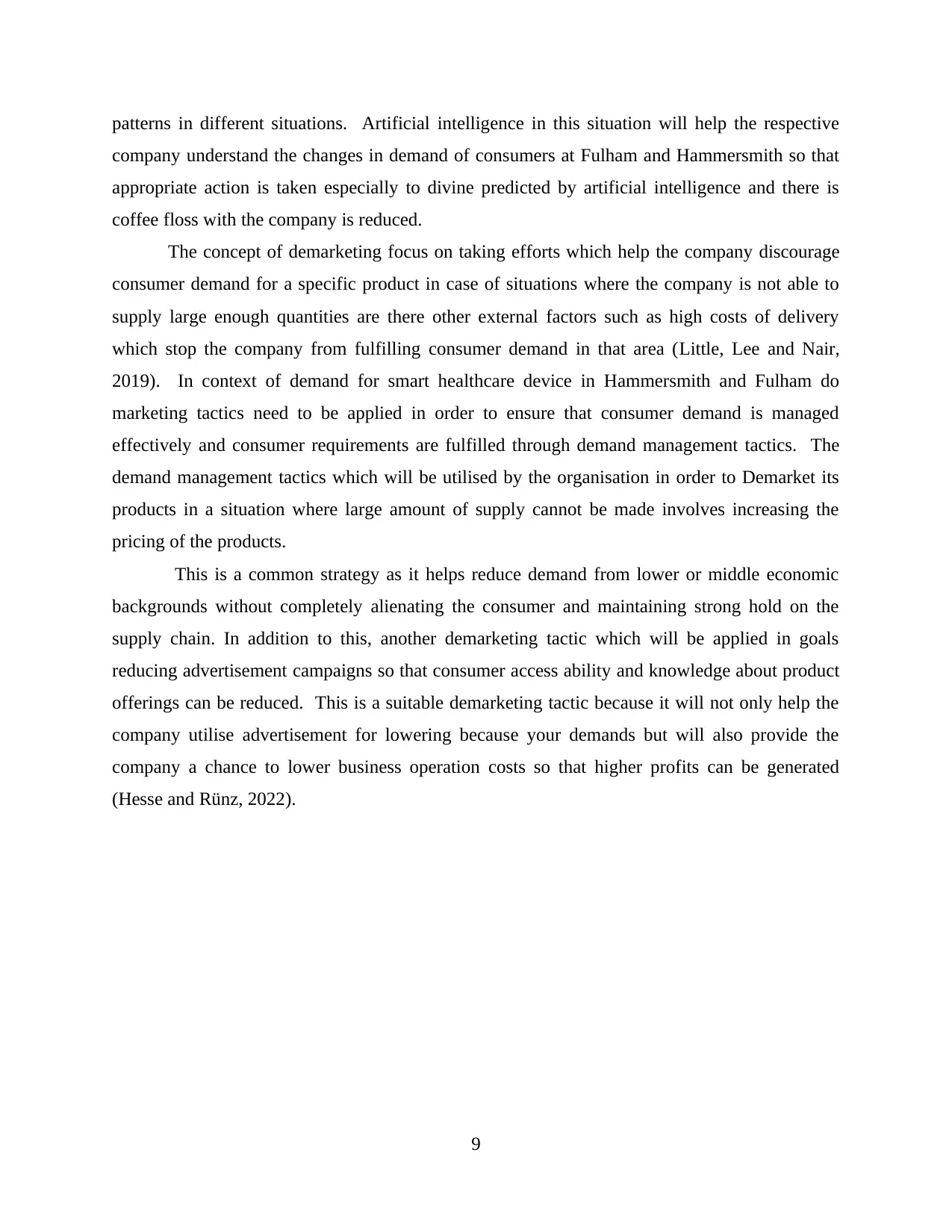
patterns in different situations. Artificial intelligence in this situation will help the respective
company understand the changes in demand of consumers at Fulham and Hammersmith so that
appropriate action is taken especially to divine predicted by artificial intelligence and there is
coffee floss with the company is reduced.
The concept of demarketing focus on taking efforts which help the company discourage
consumer demand for a specific product in case of situations where the company is not able to
supply large enough quantities are there other external factors such as high costs of delivery
which stop the company from fulfilling consumer demand in that area (Little, Lee and Nair,
2019). In context of demand for smart healthcare device in Hammersmith and Fulham do
marketing tactics need to be applied in order to ensure that consumer demand is managed
effectively and consumer requirements are fulfilled through demand management tactics. The
demand management tactics which will be utilised by the organisation in order to Demarket its
products in a situation where large amount of supply cannot be made involves increasing the
pricing of the products.
This is a common strategy as it helps reduce demand from lower or middle economic
backgrounds without completely alienating the consumer and maintaining strong hold on the
supply chain. In addition to this, another demarketing tactic which will be applied in goals
reducing advertisement campaigns so that consumer access ability and knowledge about product
offerings can be reduced. This is a suitable demarketing tactic because it will not only help the
company utilise advertisement for lowering because your demands but will also provide the
company a chance to lower business operation costs so that higher profits can be generated
(Hesse and Rünz, 2022).
9
company understand the changes in demand of consumers at Fulham and Hammersmith so that
appropriate action is taken especially to divine predicted by artificial intelligence and there is
coffee floss with the company is reduced.
The concept of demarketing focus on taking efforts which help the company discourage
consumer demand for a specific product in case of situations where the company is not able to
supply large enough quantities are there other external factors such as high costs of delivery
which stop the company from fulfilling consumer demand in that area (Little, Lee and Nair,
2019). In context of demand for smart healthcare device in Hammersmith and Fulham do
marketing tactics need to be applied in order to ensure that consumer demand is managed
effectively and consumer requirements are fulfilled through demand management tactics. The
demand management tactics which will be utilised by the organisation in order to Demarket its
products in a situation where large amount of supply cannot be made involves increasing the
pricing of the products.
This is a common strategy as it helps reduce demand from lower or middle economic
backgrounds without completely alienating the consumer and maintaining strong hold on the
supply chain. In addition to this, another demarketing tactic which will be applied in goals
reducing advertisement campaigns so that consumer access ability and knowledge about product
offerings can be reduced. This is a suitable demarketing tactic because it will not only help the
company utilise advertisement for lowering because your demands but will also provide the
company a chance to lower business operation costs so that higher profits can be generated
(Hesse and Rünz, 2022).
9
⊘ This is a preview!⊘
Do you want full access?
Subscribe today to unlock all pages.

Trusted by 1+ million students worldwide
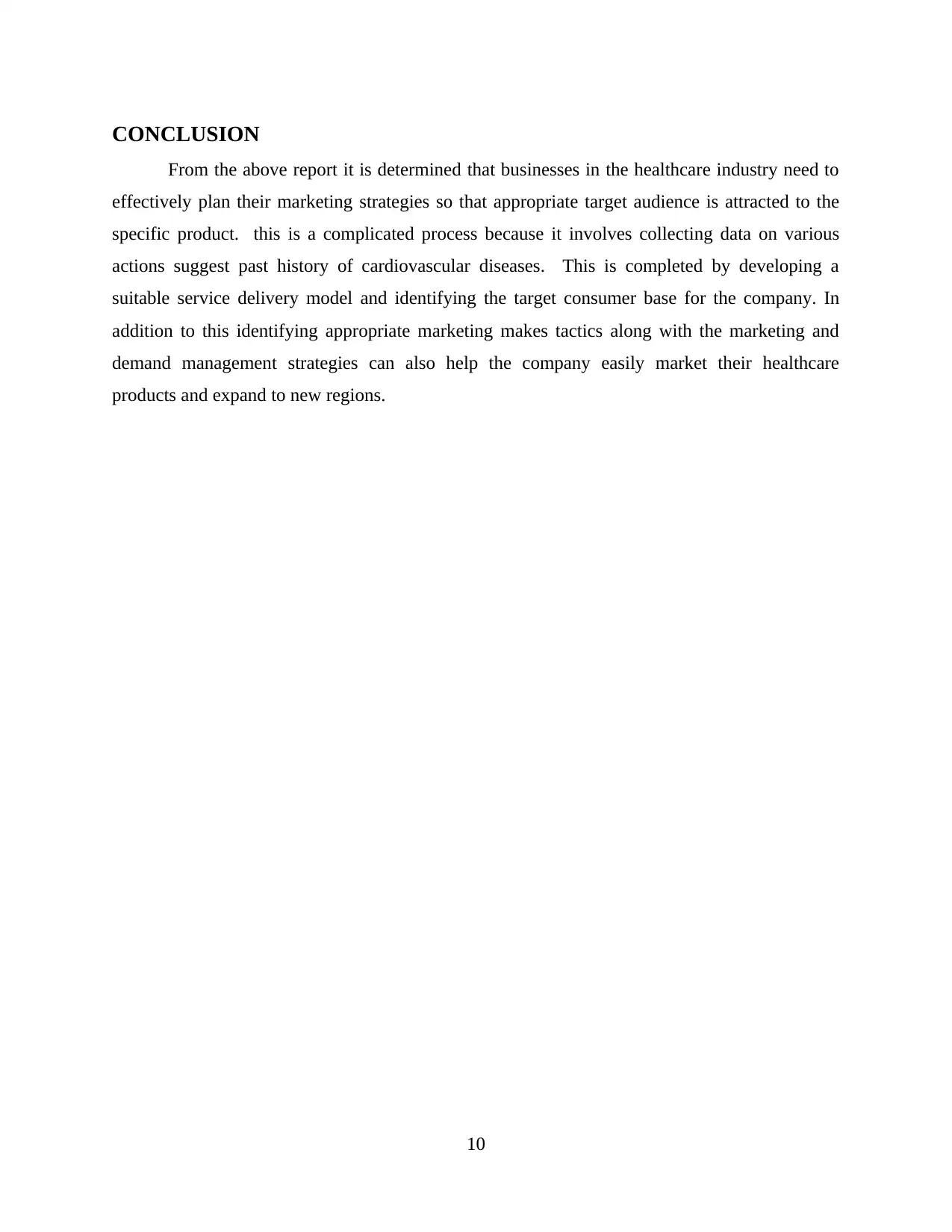
CONCLUSION
From the above report it is determined that businesses in the healthcare industry need to
effectively plan their marketing strategies so that appropriate target audience is attracted to the
specific product. this is a complicated process because it involves collecting data on various
actions suggest past history of cardiovascular diseases. This is completed by developing a
suitable service delivery model and identifying the target consumer base for the company. In
addition to this identifying appropriate marketing makes tactics along with the marketing and
demand management strategies can also help the company easily market their healthcare
products and expand to new regions.
10
From the above report it is determined that businesses in the healthcare industry need to
effectively plan their marketing strategies so that appropriate target audience is attracted to the
specific product. this is a complicated process because it involves collecting data on various
actions suggest past history of cardiovascular diseases. This is completed by developing a
suitable service delivery model and identifying the target consumer base for the company. In
addition to this identifying appropriate marketing makes tactics along with the marketing and
demand management strategies can also help the company easily market their healthcare
products and expand to new regions.
10
Paraphrase This Document
Need a fresh take? Get an instant paraphrase of this document with our AI Paraphraser
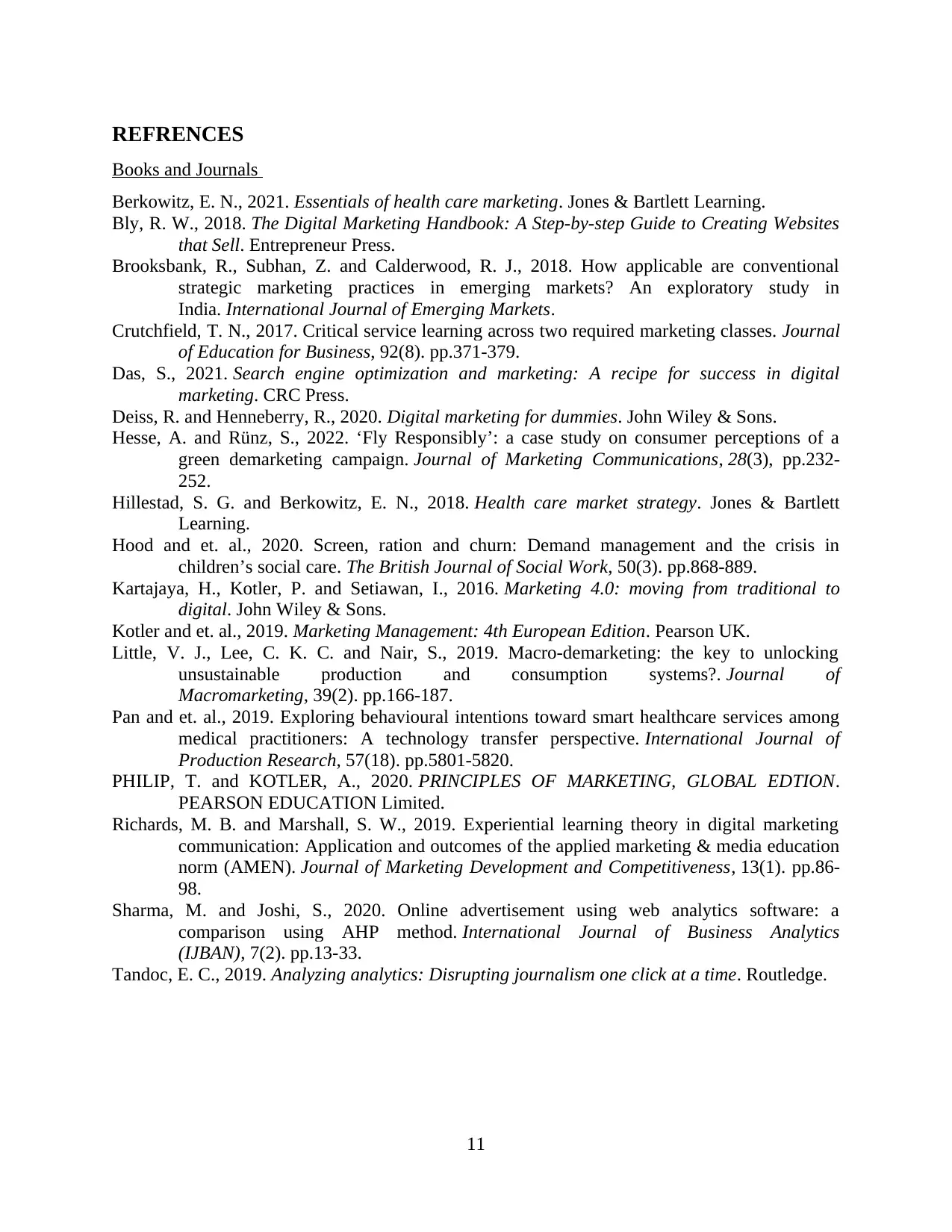
REFRENCES
Books and Journals
Berkowitz, E. N., 2021. Essentials of health care marketing. Jones & Bartlett Learning.
Bly, R. W., 2018. The Digital Marketing Handbook: A Step-by-step Guide to Creating Websites
that Sell. Entrepreneur Press.
Brooksbank, R., Subhan, Z. and Calderwood, R. J., 2018. How applicable are conventional
strategic marketing practices in emerging markets? An exploratory study in
India. International Journal of Emerging Markets.
Crutchfield, T. N., 2017. Critical service learning across two required marketing classes. Journal
of Education for Business, 92(8). pp.371-379.
Das, S., 2021. Search engine optimization and marketing: A recipe for success in digital
marketing. CRC Press.
Deiss, R. and Henneberry, R., 2020. Digital marketing for dummies. John Wiley & Sons.
Hesse, A. and Rünz, S., 2022. ‘Fly Responsibly’: a case study on consumer perceptions of a
green demarketing campaign. Journal of Marketing Communications, 28(3), pp.232-
252.
Hillestad, S. G. and Berkowitz, E. N., 2018. Health care market strategy. Jones & Bartlett
Learning.
Hood and et. al., 2020. Screen, ration and churn: Demand management and the crisis in
children’s social care. The British Journal of Social Work, 50(3). pp.868-889.
Kartajaya, H., Kotler, P. and Setiawan, I., 2016. Marketing 4.0: moving from traditional to
digital. John Wiley & Sons.
Kotler and et. al., 2019. Marketing Management: 4th European Edition. Pearson UK.
Little, V. J., Lee, C. K. C. and Nair, S., 2019. Macro-demarketing: the key to unlocking
unsustainable production and consumption systems?. Journal of
Macromarketing, 39(2). pp.166-187.
Pan and et. al., 2019. Exploring behavioural intentions toward smart healthcare services among
medical practitioners: A technology transfer perspective. International Journal of
Production Research, 57(18). pp.5801-5820.
PHILIP, T. and KOTLER, A., 2020. PRINCIPLES OF MARKETING, GLOBAL EDTION.
PEARSON EDUCATION Limited.
Richards, M. B. and Marshall, S. W., 2019. Experiential learning theory in digital marketing
communication: Application and outcomes of the applied marketing & media education
norm (AMEN). Journal of Marketing Development and Competitiveness, 13(1). pp.86-
98.
Sharma, M. and Joshi, S., 2020. Online advertisement using web analytics software: a
comparison using AHP method. International Journal of Business Analytics
(IJBAN), 7(2). pp.13-33.
Tandoc, E. C., 2019. Analyzing analytics: Disrupting journalism one click at a time. Routledge.
11
Books and Journals
Berkowitz, E. N., 2021. Essentials of health care marketing. Jones & Bartlett Learning.
Bly, R. W., 2018. The Digital Marketing Handbook: A Step-by-step Guide to Creating Websites
that Sell. Entrepreneur Press.
Brooksbank, R., Subhan, Z. and Calderwood, R. J., 2018. How applicable are conventional
strategic marketing practices in emerging markets? An exploratory study in
India. International Journal of Emerging Markets.
Crutchfield, T. N., 2017. Critical service learning across two required marketing classes. Journal
of Education for Business, 92(8). pp.371-379.
Das, S., 2021. Search engine optimization and marketing: A recipe for success in digital
marketing. CRC Press.
Deiss, R. and Henneberry, R., 2020. Digital marketing for dummies. John Wiley & Sons.
Hesse, A. and Rünz, S., 2022. ‘Fly Responsibly’: a case study on consumer perceptions of a
green demarketing campaign. Journal of Marketing Communications, 28(3), pp.232-
252.
Hillestad, S. G. and Berkowitz, E. N., 2018. Health care market strategy. Jones & Bartlett
Learning.
Hood and et. al., 2020. Screen, ration and churn: Demand management and the crisis in
children’s social care. The British Journal of Social Work, 50(3). pp.868-889.
Kartajaya, H., Kotler, P. and Setiawan, I., 2016. Marketing 4.0: moving from traditional to
digital. John Wiley & Sons.
Kotler and et. al., 2019. Marketing Management: 4th European Edition. Pearson UK.
Little, V. J., Lee, C. K. C. and Nair, S., 2019. Macro-demarketing: the key to unlocking
unsustainable production and consumption systems?. Journal of
Macromarketing, 39(2). pp.166-187.
Pan and et. al., 2019. Exploring behavioural intentions toward smart healthcare services among
medical practitioners: A technology transfer perspective. International Journal of
Production Research, 57(18). pp.5801-5820.
PHILIP, T. and KOTLER, A., 2020. PRINCIPLES OF MARKETING, GLOBAL EDTION.
PEARSON EDUCATION Limited.
Richards, M. B. and Marshall, S. W., 2019. Experiential learning theory in digital marketing
communication: Application and outcomes of the applied marketing & media education
norm (AMEN). Journal of Marketing Development and Competitiveness, 13(1). pp.86-
98.
Sharma, M. and Joshi, S., 2020. Online advertisement using web analytics software: a
comparison using AHP method. International Journal of Business Analytics
(IJBAN), 7(2). pp.13-33.
Tandoc, E. C., 2019. Analyzing analytics: Disrupting journalism one click at a time. Routledge.
11
1 out of 11
Related Documents
Your All-in-One AI-Powered Toolkit for Academic Success.
+13062052269
info@desklib.com
Available 24*7 on WhatsApp / Email
![[object Object]](/_next/static/media/star-bottom.7253800d.svg)
Unlock your academic potential
Copyright © 2020–2025 A2Z Services. All Rights Reserved. Developed and managed by ZUCOL.



